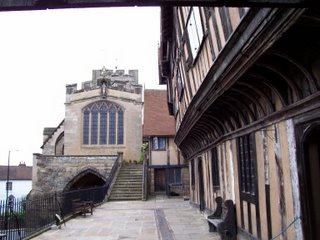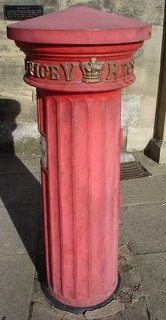This afternoon, Clara and I drove to Warwick on a reconnaissance mission to find the Newburgh Primary School, where Will has his first oboe lesson tomorrow evening. The drive involved about ten minutes on the A46, including a mega-roundabout shaped like a partially-amputated monster octopus stretching its tentacles in five or six directions. Clara drove brilliantly, and even got us in and out of a shoebox-sized parking garage in Warwick town, where we went to visit the Lord Leycester Hospital.

 The "hospital" has been, since Robert Dudley, Lord Leicester, endowed it in 1571, a retirement home for disabled soldiers—one of whom, an old curmudgeon, sold us tickets at the entrance. The ancient half-timbered buildings date back to the fifteenth-century and earlier, and are among the only buildings in Warwick to have survived the great fire of 1698. The Great Hall was built in 1383, when the buildings housed Warwick's medieval Guilds. The lovely little Chapel of St. James the Great was built over the west gate into the town of Warwick in 1123, rebuilt in 1383, and remodelled several times in subsequent years; the tower was added in 1450. Among the highlights of the chapel are a small stained glass window and altar hangings by William Morris, and some remarkable woodcarving.
The "hospital" has been, since Robert Dudley, Lord Leicester, endowed it in 1571, a retirement home for disabled soldiers—one of whom, an old curmudgeon, sold us tickets at the entrance. The ancient half-timbered buildings date back to the fifteenth-century and earlier, and are among the only buildings in Warwick to have survived the great fire of 1698. The Great Hall was built in 1383, when the buildings housed Warwick's medieval Guilds. The lovely little Chapel of St. James the Great was built over the west gate into the town of Warwick in 1123, rebuilt in 1383, and remodelled several times in subsequent years; the tower was added in 1450. Among the highlights of the chapel are a small stained glass window and altar hangings by William Morris, and some remarkable woodcarving. Other treasures on display in the hospital are a chair in which King James I sat on his visit to Warwick in 1617, some needlework from Cumnor Hall attributed to Amy Robsart (read Sir Walter Scott's Kenilworth to find out about the ill-fated Amy), and a wardrobe used by Queen Elizabeth I on her visit to Kenilworth Castle. The hospital also wraps around two lovely small gardens, the Master's Garden and the "millenium" knot garden, constructed in 2000. Also, just inside the medieval town gate is a rare pillar-shaped post box (with a vertical slot) from the reign of Queen Victoria (VR, for Victoria Regina).
Other treasures on display in the hospital are a chair in which King James I sat on his visit to Warwick in 1617, some needlework from Cumnor Hall attributed to Amy Robsart (read Sir Walter Scott's Kenilworth to find out about the ill-fated Amy), and a wardrobe used by Queen Elizabeth I on her visit to Kenilworth Castle. The hospital also wraps around two lovely small gardens, the Master's Garden and the "millenium" knot garden, constructed in 2000. Also, just inside the medieval town gate is a rare pillar-shaped post box (with a vertical slot) from the reign of Queen Victoria (VR, for Victoria Regina).We were home in time for one of my favorite programmes on BBC Radio 3: Choral Evensong. The programme has been broadcast continually on BBC Radio since October 7, 1926, which means that next week's programme is roughly its 80th anniversary. By clicking on the link above, you will find an audio link allowing you to listen to the programme (Real Player required). For those of you in the Central Time Zone, the programme would be on at 11:00 a.m.


No comments:
Post a Comment